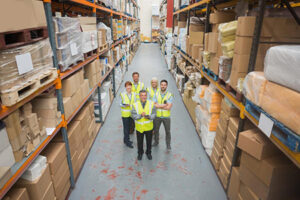Building a connected warehouse is one of the best ways in which you can optimize your inventory for your business. The first thing you need to realize is that a connected warehouse is developed in a manner which allows you to tangibly keep track of all data within a warehouse. This means data relating to inventory, storage, delivery and more of the contents inside it.
Many businesses don’t account for noting this data properly, which can create confusion and lead to inventory problems and other issues that can seriously hamper your productivity. With a connected warehouse, you can simplify a lot of these issues with ease. Moreover, a connected warehouse is one which is linked not only with the supply chain, but also with the resource planning as well as the customer services of a business.
Linking the warehouse with all these systems not only facilitates data entry, it also allows for more credible future planning. This allows you to streamline the warehouse to get a better understanding of various factors such as the carrying costs, the inventory turnover and learning how to manage stock levels that are largely based on supply and demand of the business’s target market.
In theory, building a connected warehouse can appear rather intimidating since there are so many different factors to take into account. Luckily, in order to build a connected warehouse, you should start by focusing on the following aspects.
Getting a workable space in the warehouse
One of the biggest problems that people encounter when it comes to building a connected warehouse happens to be working space. Many warehouses have files which are nothing more than a folder that the workers will bring with them and write on as is. There are no proper storage options or even a computer which can make the processing of inventory, delivered goods and other functions simpler.

A good way to counter this is by focusing on creating a workable space within the warehouse. Again, this proves to be challenging with limited space but you don’t have to make major changes. Just make use of mezzanine flooring options that allow you to build an office space or a workstation inside the warehouse. The best part about using this flooring is the wide array of customization options that they have to offer. In fact, mezzanine flooring can be customized to make room for bathroom fixtures, kitchen fixtures, air conditioners and more.
In this manner, you not only give someone a workable space but also one that makes the warehouse more comfortable for them to work in. With a computer system right in the warehouse, they can easily speed up inventory data and process delivery forms easier as well. It also creates greater transparency in terms of processing and data work as well as accounting for any delays. This data can also prove to be invaluable in identifying areas which can benefit from any cost-efficient additions.
Keeping track of inventory
You can do this by assigning different pallet racking to different products and having a code, colour or barcode for them. By grouping them together in this manner, you can compartmentalize your inventory more effectively. Physically counting inventory is now largely outmoded. Having to count inventory in a warehouse is not something which can be done physically without wasting a lot of time and energy. Linking it with software can allow you to keep track of inventory more effectively and what would previously have taken hours or even a few days can now get done within minutes.
You will also be able to get a better log of available supplies, what is needed, what can be discarded as well as predict future demand of a product with the help of pallet racking. Another added measure that you should opt for is by adopting software for security so you have an idea of who accessed the inventory at what time and which date. This tangible data can prevent mistakes, missing pieces and also ensure that the products are always safe and secure when they are in the storage in your warehouse.

A connected warehouse can help you to keep track of inventory by allowing you to understand the level of supply and demand that your products have. Moreover, lost goods can translate into lost profits so keeping a proper inventory is necessary. By developing a tangible system which allows you to track your inventory properly, you can easily improve your inventory functions and keep an eye on how the demand and supply are functioning. A major way to do this is by having a software system, which makes it easier to keep track of what is stacked on the pallets.
Organization in storage
any warehouses have a wide layout, which has to be strictly organized otherwise it can quickly become messy. Even if years ago, the warehouse was exceptionally functional, take the time to evaluate whether the storage options are still up to par or not. In many cases, the warehouse can morph into a disorganized mess and if left unchecked, this mess can grow until there is a lot of chaos. To prevent this from happening and to bring more organization into storage, make use of shelving options such as pallet racking.

These are perfect for limited spaces and they can really streamline a warehouse with ease. Another interesting thing to note here is the fact that pallet racking is available for different warehouse systems. Whether you are storing dry goods, automobile parts and vehicles or just other raw materials, you can find the perfect pallet racking system for your warehouse with ease.
In some cases, you can even opt to get customized pallet racking which is meant to enhance flexibility and ease of use. By organizing your storage in this manner, you can also reduce wastage of time, improve functionality and ensure that there are no missing pieces and no room for error. In this manner, you can effectively streamline and make a connected warehouse that is extremely beneficial for your business.
With the help of the three major tips mentioned above, you can build a connected warehouse which is a valuable addition to your business and aids in its growth with ease.
